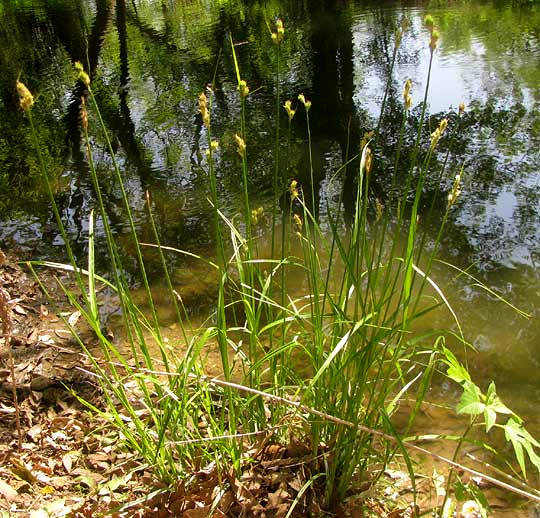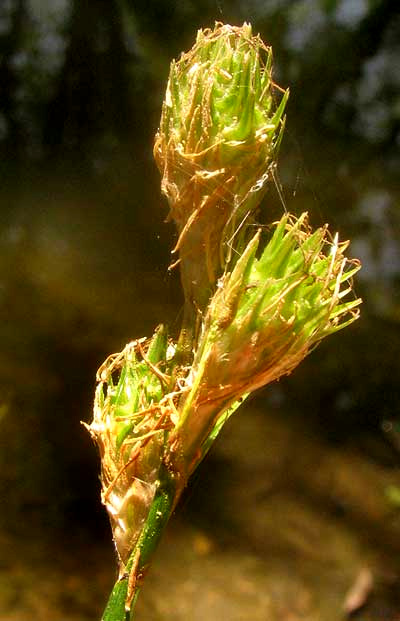Excerpts from Jim Conrad's
Naturalist Newsletter
from the April 13, 2014 Newsletter issued from the Frio Canyon Nature Education Center in the valley of the Dry Frio River in northern Uvalde County, southwestern Texas, on the southern border of the Edwards Plateau; elevation ~1750m (~5750 ft); N29.62°, W99.86°; USA
BRITTON'S SEDGE
In mud along the banks of the little Leona River coursing through Memorial Park in Uvalde, a grasslike sedge flowered handsomely in afternoon sunlight. You can see its classic sedge form below:

True sedges like this plant are members of the genus Carex, of the Sedge Family, the Cyperaceae. However, about 2000 Carex species are recognized, and the online Flora of North America treats 480 species for North America -- with about 74 of those growing in Texas -- so usually when you find a sedge, figuring out which sedge it is can be challenging.
This sedge offered some very distinctive field marks however. Below, you can begin seeing them in a close-up of a head displaying some of the basic features making a sedge and sedge:

Sedges are such unique beings that to talk about them you need several special sedge terms. In fact, there's a special name for the study of sedges, which is "caricology."
In the above picture you see three spikes at the tip of a flowering stem, each spike bearing several unisexual flowers of both sexes. All three spikes have the male flowers below the female ones, a condition said to be "gynecandrous." Most sedge species don't produce gynecandrous spikes, so noticing this is a big help.
In the spikes, the male flowers have slender, yellowish anthers dangling from them while female flowers consist of a scale, or bract, arising below a green, frying-pan-shaped item, the "perigynium," with an elongate, sharp "beak" pointing upward. Looking closely at the perigynium, you see important features helping us zero in on the species, as seen below:

Here you can see that inside the perigynium a darkened area. That's a hard, dry, one-seeded, non-splitting achene-type fruit or nut. Perignyia, then, aren't fruits, but rather bladder-like coverings of fruits. And perignyia come in a bewildering variety of different shapes and sizes. In fact, to identify a sedge to species level you simply have to pay close attention to its perignyia. Important to note about our sedge's perigynium is that it's flattened, not rounded, and its beak consists of two sharp teeth, not three. Only a minority of sedge species share these traits, so once again these are important field marks.
Other field marks leading us to the exact species include the fact that the hairless perigynium is about 6mm wide, it's more or less spherical or even wider than long, its sides bear conspicuous, papery "wings," and its flat faces bear no clearly visible veins.
All this brings us to CAREX TETRASTACHYA, often known as Britton's Sedge because earlier its binomial was given as Carex brittoniana.
A 2010 publication of the Nueces River Authority, a field guide to riparian plants within the Nueces River Basin, informs us that of Texas's 74 sedge species only six occur in the Rio Grande Plains and the lower Nueces Basin, and that the Britton's Sedge is one of those -- in fact, it's the one species the guide illustrates, as an example of a sedge.
Though apparently common in our area, Britton Sedge is endemic only to Texas, Oklahoma, and a tiny part of Louisiana. It's to be found in moist prairies, shores, banks and roadside ditches. As the season develops, the sedge's perignyia inflate, the spikes increase in size, and begin looking like the spiky, green fruiting heads of Sweetgum trees.